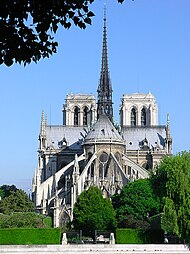Engineering:Flèche


A flèche (French: flèche, lit. 'arrow'[3]) is the name given to spires in Gothic architecture: in French the word is applied to any spire, but in English it has the technical meaning of a spirelet or spike on the rooftop of a building.[4][5] In particular, the spirelets often built atop the crossings of major churches in mediaeval French Gothic architecture are called flèches.[5]
On the ridge of the roof on top of the crossing (the intersection of the nave and the transepts) of a church, flèches were typically light, delicate, timber-framed constructions with a metallic sheath of lead or copper.[6] They are often richly decorated with architectural and sculptural embellishments: tracery, crockets, and miniature buttresses serve to adorn the flèche.[6]
Flèches are often very tall: the Gothic Revival spire of Notre-Dame de Paris (1858–2019) by Eugène Viollet-le-Duc was about 100 feet (30 m) before its destruction in the Notre-Dame de Paris fire, while the 16th century flèche of Amiens Cathedral is 148 feet (45 m) high.[6]
The highest flèche in the world was built at the end of the 19th century for Rouen Cathedral, 157 metres (515 ft) high in total.[citation needed]
A short spire or flèche surrounded by a parapet is common on churches in Hertfordshire; as a result this type of flèche is called a Hertfordshire spike.[7]
See also
- Flèche faîtière
- Ridge turret
Notes
- ↑ Curl, James Stevens; Wilson, Susan, eds. (2015), "Lassus, Jean-Baptiste-Antoine" (in en), A Dictionary of Architecture and Landscape Architecture (Oxford University Press), doi:10.1093/acref/9780199674985.001.0001/acref-9780199674985-e-2613, ISBN 978-0-19-967498-5, https://www.oxfordreference.com/view/10.1093/acref/9780199674985.001.0001/acref-9780199674985-e-2613, retrieved 2020-05-27
- ↑ Curl, James Stevens; Wilson, Susan, eds. (2015), "Bazhenov, Vasily Ivanovich" (in en), A Dictionary of Architecture and Landscape Architecture (Oxford University Press), doi:10.1093/acref/9780199674985.001.0001/acref-9780199674985-e-476, ISBN 978-0-19-967498-5, https://www.oxfordreference.com/view/10.1093/acref/9780199674985.001.0001/acref-9780199674985-e-476, retrieved 2020-05-27
- ↑ "Definition of Spirelet". https://www.collinsdictionary.com/dictionary/english/spirelet.
- ↑ Curl, James Stevens; Wilson, Susan, eds. (2015), "spire" (in en), A Dictionary of Architecture and Landscape Architecture (Oxford University Press), doi:10.1093/acref/9780199674985.001.0001/acref-9780199674985-e-4392, ISBN 978-0-19-967498-5, https://www.oxfordreference.com/view/10.1093/acref/9780199674985.001.0001/acref-9780199674985-e-4392, retrieved 2020-05-27
- ↑ 5.0 5.1 Curl, James Stevens; Wilson, Susan, eds. (2015), "flèche" (in en), A Dictionary of Architecture and Landscape Architecture (Oxford University Press), doi:10.1093/acref/9780199674985.001.0001/acref-9780199674985-e-1827, ISBN 978-0-19-967498-5, https://www.oxfordreference.com/view/10.1093/acref/9780199674985.001.0001/acref-9780199674985-e-1827, retrieved 2020-05-27
- ↑ 6.0 6.1 6.2 "Flèche | architecture". http://www.britannica.com/EBchecked/topic/209889/fleche.
- ↑ Curl, James Stevens; Wilson, Susan, eds. (2015), "Hertfordshire spike" (in en), A Dictionary of Architecture and Landscape Architecture (Oxford University Press), doi:10.1093/acref/9780199674985.001.0001/acref-9780199674985-e-2249, ISBN 978-0-19-967498-5, https://www.oxfordreference.com/view/10.1093/acref/9780199674985.001.0001/acref-9780199674985-e-2249, retrieved 2020-05-27



